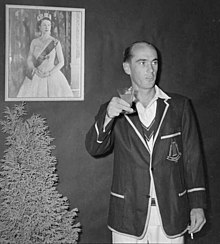 Craig in New Zealand in 1960 | ||||||||||||||||||||||||||||||||||||||||
| Personal information | ||||||||||||||||||||||||||||||||||||||||
|---|---|---|---|---|---|---|---|---|---|---|---|---|---|---|---|---|---|---|---|---|---|---|---|---|---|---|---|---|---|---|---|---|---|---|---|---|---|---|---|---|
| Full name | Ian David Craig | |||||||||||||||||||||||||||||||||||||||
| Born | 12 June 1935 Yass, New South Wales, Australia | |||||||||||||||||||||||||||||||||||||||
| Died | 16 November 2014 (aged 79) Bowral, New South Wales, Australia | |||||||||||||||||||||||||||||||||||||||
| Nickname | The Colt[1] | |||||||||||||||||||||||||||||||||||||||
| Height | 1.73 m (5 ft 8 in) | |||||||||||||||||||||||||||||||||||||||
| Batting | Right-handed | |||||||||||||||||||||||||||||||||||||||
| Role | Batsman | |||||||||||||||||||||||||||||||||||||||
| International information | ||||||||||||||||||||||||||||||||||||||||
| National side | ||||||||||||||||||||||||||||||||||||||||
| Test debut (cap 194) | 6 February 1953 v South Africa | |||||||||||||||||||||||||||||||||||||||
| Last Test | 28 February 1958 v South Africa | |||||||||||||||||||||||||||||||||||||||
| Domestic team information | ||||||||||||||||||||||||||||||||||||||||
| Years | Team | |||||||||||||||||||||||||||||||||||||||
| 1951/52–1961/62 | New South Wales | |||||||||||||||||||||||||||||||||||||||
| Career statistics | ||||||||||||||||||||||||||||||||||||||||
| ||||||||||||||||||||||||||||||||||||||||
Source: CricInfo, 7 April 2008 | ||||||||||||||||||||||||||||||||||||||||
Ian David Craig OAM (12 June 1935 – 16 November 2014) was an Australian cricketer who represented the Australian national team in 11 Tests between 1953 and 1958. A right-handed batsman, Craig holds the records for being the youngest Australian to make a first-class double century, appear in a Test match, and captain his country in a Test match. Burdened by the public expectation of being the "next Bradman", Craig's career did not fulfil its early promise. In 1957, he was appointed Australian captain, leading a young team as part of a regeneration plan following the decline of the national team in the mid-1950s, but a loss of form and illness forced him out of the team after one season. Craig made a comeback, but work commitments forced him to retire from first-class cricket at only 26 years of age.
A teenage prodigy, Craig made his first-class debut for New South Wales in the last match of the 1951–52 Australian season, aged only 16. The following summer, Craig earned comparisons to Don Bradman, generally regarded as the greatest batsman of all time, after becoming the youngest player to score a first-class double century, an unbeaten 213 against the touring South African team. The innings secured Craig's Test debut in the final match against South Africa, making him the youngest male player to represent Australia in a Test, aged 17 years and 239 days. Craig started his Test career well, scoring 53 and 47 to ensure his selection for the 1953 Ashes tour, making him the youngest Australian player to tour England. Craig's arrival precipitated media comparisons to the arrival and success of Bradman in 1930, but he performed poorly and was not selected for any of the Tests.
Having missed a season due to national service and university studies, Craig returned to first-class cricket in 1955–56, earning a place in the 1956 Ashes touring squad. Craig regained a Test position for the final two Tests of the series. After the series, at which point Australia had suffered three consecutive Ashes series defeats, captain Ian Johnson and vice-captain Keith Miller retired. The selectors focussed on young players to rebuild the team, appointing Craig as the captain for the 1957–58 tour of South Africa, although he had played just six Tests and was not an established member of the team. Aged 22 years and 194 days, Craig was, at the time, the youngest captain in Test history and led a team that critics dismissed as having no chance to a convincing 3–0 victory; his own batting form was poor, and he averaged less than 20. He contracted hepatitis before the start of the 1958–59 season and withdrew from cricket. Although he returned the following season for New South Wales, he could not regain his Test place. He retired from first-class cricket at the age of just 26: work commitments as a pharmacist increasingly restricted his ability to train. In later life, Craig was the managing director of the Australian subsidiary of the British pharmaceutical firm Boots. He had a continued involvement with cricket as an administrator, working with the New South Wales Cricket Association, the Sydney Cricket Ground Trust and the Bradman Museum. Craig was awarded the Medal of the Order of Australia in 1997 for his service to cricket.